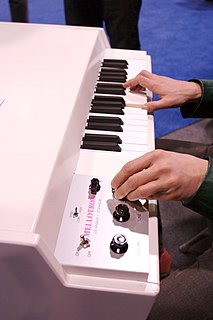See also
| This disambiguation page lists articles associated with the title Electronic rock. If an internal link led you here, you may wish to change the link to point directly to the intended article. |
Electronic rock is a music genre that involves a combination of rock music and electronic music.
Electronic rock may also refer to:
| This disambiguation page lists articles associated with the title Electronic rock. If an internal link led you here, you may wish to change the link to point directly to the intended article. |
New wave is a music genre that encompasses numerous pop-oriented styles from the late 1970s and the 1980s. It was originally used as a catch-all for the music that emerged after punk rock, including punk itself, but may be viewed retrospectively as a more accessible counterpart of post-punk. Although new wave shared punk's DIY philosophy, the artists were more influenced by the lighter strains of 1960s pop while opposed to mainstream "corporate" rock, which they considered creatively stagnant, and the generally abrasive and political bents of punk rock.

Progressive music is music that attempts to expand existing stylistic boundaries associated with specific genres of music. The word comes from the basic concept of "progress", which refers to development and growth by accumulation, and is often deployed in the context of distinct genres such as progressive country, progressive folk, progressive jazz, and progressive rock. Music that is deemed "progressive" usually synthesizes influences from various cultural domains, such as European art music, Celtic folk, West Indian, or African. It is rooted in the idea of a cultural alternative and may also be associated with auteur-stars and concept albums, considered traditional structures of the music industry.
Synth-pop is a subgenre of new wave music that first became prominent in the late 1970s and features the synthesizer as the dominant musical instrument. It was prefigured in the 1960s and early 1970s by the use of synthesizers in progressive rock, electronic, art rock, disco, and particularly the "Krautrock" of bands like Kraftwerk. It arose as a distinct genre in Japan and the United Kingdom in the post-punk era as part of the new wave movement of the late 1970s to the mid-1980s.
Popular music of the United Kingdom in the 1970s built upon the new forms of music developed from blues rock towards the end of the 1960s, including folk rock and psychedelic rock. Several important and influential subgenres were created in Britain in this period, by pursuing the limitations of rock music, including British folk rock and glam rock, a process that reached its apogee in the development of progressive rock and one of the most enduring subgenres in heavy metal music. Britain also began to be increasingly influenced by third world music, including Jamaican and Indian music, resulting in new music scenes and subgenres. In the middle years of the decade the influence of the pub rock and American punk rock movements led to the British intensification of punk, which swept away much of the existing landscape of popular music, replacing it with much more diverse new wave and post punk bands who mixed different forms of music and influences to dominate rock and pop music into the 1980s.
Popular music of the United Kingdom in the 1980s built on the post-punk and new wave movements, incorporating different sources of inspiration from subgenres and what is now classed as world music in the shape of Jamaican and Indian music. It also explored the consequences of new technology and social change in the electronic music of synthpop. In the early years of the decade, while subgenres like heavy metal music continued to develop separately, there was a considerable crossover between rock and more commercial popular music, with a large number of more "serious" bands, like The Police and UB40, enjoying considerable single chart success. The advent of MTV and cable video helped spur what has been seen as a Second British Invasion in the early years of the decade, with British bands enjoying more success in America than they had since the height of the Beatles' popularity in the 1960s. However, by the end of the decade a fragmentation has been observed, with many new forms of music and sub-cultures, including hip hop and house music, while the single charts were once again dominated by pop artists, now often associated with the Hi-NRG hit factory of Stock Aitken Waterman. The rise of the indie rock scene was partly a response to this, and marked a shift away from the major music labels and towards the importance of local scenes like Madchester and subgenres, like gothic rock.
Modern rock is rock music that followed the 1970s punk rock scene made between the mid 1970s to present day. Some radio stations use this term to distinguish themselves from classic rock, which is based in 1960s–1980s rock music.
Dance-punk is a post-punk genre that emerged in the late 1970s, and is closely associated with the post-disco and new wave movements.
Dance-rock is a post-disco genre connected with pop rock and post-punk with fewer rhythm and blues influences, originated in the early 1980s, following the decline in popularity of punk and disco.
Cold wave is a loose music genre that emerged in Europe the late 1970s, characterized by its detached lyrical tone, use of early electronic music instruments and a minimalist approach and style. It emerged from punk rock bands who, influenced by early electronic groups such as Kraftwerk, made use of affordable portable synthesizers such as the Korg MS-20.

Dance music is music composed specifically to facilitate or accompany dancing. It can be either a whole musical piece or part of a larger musical arrangement. In terms of performance, the major categories are live dance music and recorded dance music. While there exist attestations of the combination of dance and music in ancient times, the earliest Western dance music that we can still reproduce with a degree of certainty are the surviving medieval dances. In the Baroque period, the major dance styles were noble court dances. In the classical music era, the minuet was frequently used as a third movement, although in this context it would not accompany any dancing. The waltz also arose later in the classical era. Both remained part of the romantic music period, which also saw the rise of various other nationalistic dance forms like the barcarolle, mazurka, ecossaise, ballade and polonaise.
Nu-disco is a 21st-century dance music genre associated with a renewed interest in the late 1970s US disco, synthesizer-heavy 1980s European dance music styles, and early 1990s electronic dance music. The genre was especially popular in the first half of the 2000s, and experienced another small resurgence through the 2010s.
A number of overlapping punk rock subgenres have developed since the emergence of punk rock in the mid-1970s. Even though punk genres at times are difficult to segregate, they usually show differing characteristics in overall structures, instrumental and vocal styles, and tempo. However, sometimes a particular trait is common in several genres, and thus punk genres are normally grouped by a combination of traits.

The use of electronic music technology in rock music coincided with the practical availability of electronic musical instruments and the genre's emergence as a distinct style. Rock music has been highly dependent on technological developments, particularly the invention and refinement of the synthesizer, the development of the MIDI digital format and computer technology.
Electronic rock is a music genre that involves a combination of rock music and electronic music, featuring instruments typically found within both genres. It originates from the late 1960s, when rock bands began incorporating electronic instrumentation into their music. Electronic rock acts usually fuse elements from other music styles, including punk rock, industrial rock, hip hop, techno, and synth-pop, which has helped spur subgenres such as indietronica, dance-punk, and electroclash.